Nestled in Northwest Michigan, Northern Michigan Hardwoods is amidst some of the finest hardwood forests in the world. The changing of the seasons creates one of the world's best growing environments for hardwood trees. This allows us to offer the most prized lumber to create beautiful cabinetry, flooring and other specialty items.
Wood is a natural resource, no two floor boards will be identical. Variations in appearance are completely normal. As your floor ages, some color change can occur. This is normal but can be minimized by limiting exposure to direct sunlight and periodically moving furniture and rugs. Wood floors will also show signs of wear over time. Put felt pads on the bottoms of any furniture to minimize scratches and dents. Place rugs at all entrances, avoiding those with rubber backs, which can discolor your floor. Avoid walking on your floors with cleats or high heels. By taking these precautions, your wood floor will stay looking beautiful and timeless.
Wood is "hygroscopic" meaning it will absorb moisture during periods of high humidity and it will release moisture during periods of low humidity. When moisture is high, the wood will swell causing the boards to expand. When the air is dry, the wood will shrink causing cracks to open up between the floor boards. Cracks are normal and will appear and disappear between floor boards during seasons of high and low humidity. For best results, keep the relative humidity in the home between 35-60% year round.
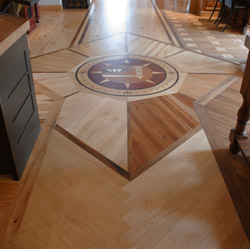
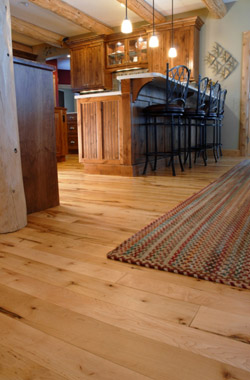
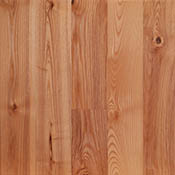 Ash is known for its great strength and excellent workable properties. In the early 1930s, Admiral Richard Byrd wore snowshoes made from ash during his polar expeditions. The color of ash is somewhat lustrous; cream to very light brown heartwood with lighter colored sapwood. Ash has a straight moderately open grain and takes a finish very well.
Ash is known for its great strength and excellent workable properties. In the early 1930s, Admiral Richard Byrd wore snowshoes made from ash during his polar expeditions. The color of ash is somewhat lustrous; cream to very light brown heartwood with lighter colored sapwood. Ash has a straight moderately open grain and takes a finish very well.
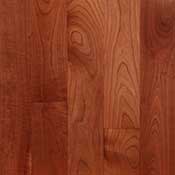 Cherry was used by the Greeks and Romans as long ago as 400 B.C. for furniture making. Cherry helped define American traditional design because Colonial wood workers recognized its superior woodworking qualities. It has a rich reddish brown color that deepens with age and exposure to sunlight. Its exceptionally lustrous appearance almost glows. It's straight-grained and satiny, and sometimes contains pin knots and gum pockets that give the wood a distinctive character. Its more uniform texture takes a stain very well. Cherry is light, strong, stiff and rather soft compared to maple or hickory.
Cherry was used by the Greeks and Romans as long ago as 400 B.C. for furniture making. Cherry helped define American traditional design because Colonial wood workers recognized its superior woodworking qualities. It has a rich reddish brown color that deepens with age and exposure to sunlight. Its exceptionally lustrous appearance almost glows. It's straight-grained and satiny, and sometimes contains pin knots and gum pockets that give the wood a distinctive character. Its more uniform texture takes a stain very well. Cherry is light, strong, stiff and rather soft compared to maple or hickory.
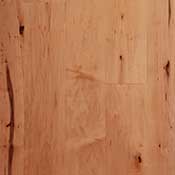 Hard Maple - Fascinatingly, in the 1920s, airplane propellers were made from maple, as well as the heels of women's shoes. Maple has been a favorite of American wood workers since early Colonial days. Maple coloring ranges from cream to light reddish-brown, with a uniform grain and texture. Maple is heavy, hard, strong, tough and stiff with excellent resistance to abrasion and indentation - ideal for wood flooring or butcher block cutting boards and countertops.
Hard Maple - Fascinatingly, in the 1920s, airplane propellers were made from maple, as well as the heels of women's shoes. Maple has been a favorite of American wood workers since early Colonial days. Maple coloring ranges from cream to light reddish-brown, with a uniform grain and texture. Maple is heavy, hard, strong, tough and stiff with excellent resistance to abrasion and indentation - ideal for wood flooring or butcher block cutting boards and countertops.
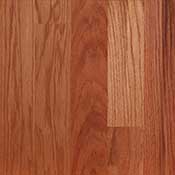 Oak has a long, notable history in furnishings and interior design. It was a favorite of early English craftsmen and a prized material for American colonists. Red oak grows only in North America and is found further north than any other oak species. A red oak grows slowly, taking 20 years to mature and living an average of 300 years. Red Oak ranges from creamy white to a warm, pale brown color, with tints of red. The grain is known for its "rays," which reflect light and add to its appeal. Depending on the way the logs are sawn into timber (rift cut, flat sliced, flat sawn, rotary cut, quarter sawn), many distinctive and sought after patterns can emerge. Oak is heavy, strong, hard, stiff and durable under exposure. Oaks take a wide range of finishes very well.
Oak has a long, notable history in furnishings and interior design. It was a favorite of early English craftsmen and a prized material for American colonists. Red oak grows only in North America and is found further north than any other oak species. A red oak grows slowly, taking 20 years to mature and living an average of 300 years. Red Oak ranges from creamy white to a warm, pale brown color, with tints of red. The grain is known for its "rays," which reflect light and add to its appeal. Depending on the way the logs are sawn into timber (rift cut, flat sliced, flat sawn, rotary cut, quarter sawn), many distinctive and sought after patterns can emerge. Oak is heavy, strong, hard, stiff and durable under exposure. Oaks take a wide range of finishes very well.
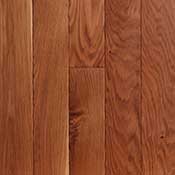 Northern White Oak is a truly classic species with its dense and coarse open grain. It is very strong and hard, but with good steam bending properties. Revered for its neutral brown to tan color tones and ability to accept a variety of stains and finishes, this species offers a warmth and classic look desired by artisans for centuries. White Oak is used to make furniture, cabinets, wine and whisky barrels, exposed timber frame construction, flooring and millwork. It is durable, beautiful and timeless as a hardwood flooring species.
Northern White Oak is a truly classic species with its dense and coarse open grain. It is very strong and hard, but with good steam bending properties. Revered for its neutral brown to tan color tones and ability to accept a variety of stains and finishes, this species offers a warmth and classic look desired by artisans for centuries. White Oak is used to make furniture, cabinets, wine and whisky barrels, exposed timber frame construction, flooring and millwork. It is durable, beautiful and timeless as a hardwood flooring species.
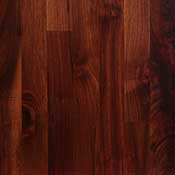 Walnut is a beautiful hardwood with a figured grain. Walnut ranges from creamy white to a dark, chocolate brown color. It can contain a lot of character in the grain and looks great in a variety of finishes. Walnut is versatile and popular, since its luster grows over time.
Walnut is a beautiful hardwood with a figured grain. Walnut ranges from creamy white to a dark, chocolate brown color. It can contain a lot of character in the grain and looks great in a variety of finishes. Walnut is versatile and popular, since its luster grows over time.
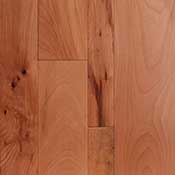 Because beech steam-bends as readily as ash, it works well for chair legs and backs. In fact, this under-used wood could be made into any type of interior furniture, cabinets, flooring, and trim. As drawers, beech actually becomes slicker as it rubs against other wood members.
Because beech steam-bends as readily as ash, it works well for chair legs and backs. In fact, this under-used wood could be made into any type of interior furniture, cabinets, flooring, and trim. As drawers, beech actually becomes slicker as it rubs against other wood members.
Wood turners use beech for items such as goblets with delicate stems. It's also ideal for food-use vessels like cutting boards and spoons because it imparts no odor or taste, and takes abuse.
5151 Manthei Rd.
Petoskey, MI 49770